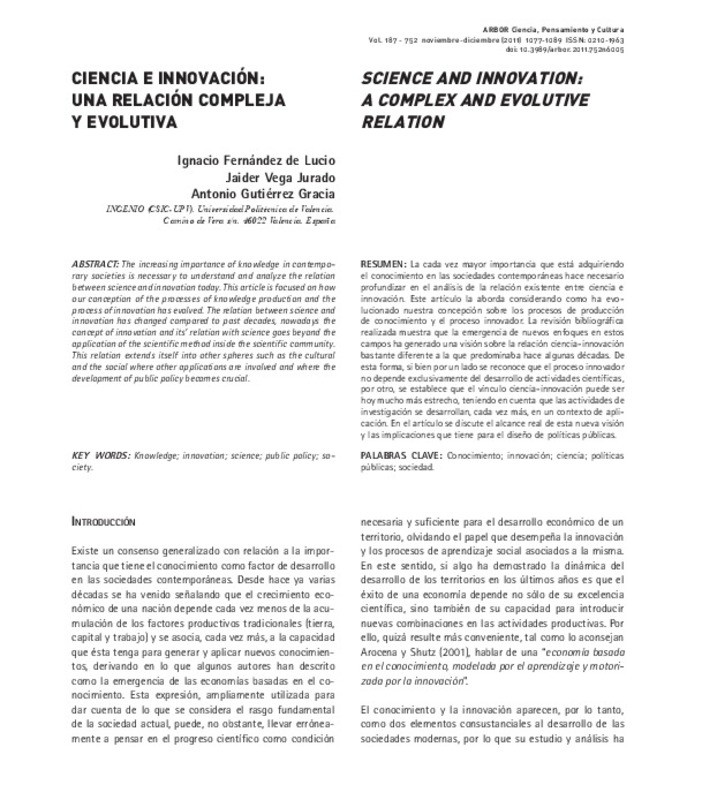Cohen, W. M., & Levinthal, D. A. (1989). Innovation and Learning: The Two Faces of R & D. The Economic Journal, 99(397), 569. doi:10.2307/2233763
Cooke, P. (1992). Regional innovation systems: Competitive regulation in the new Europe. Geoforum, 23(3), 365-382. doi:10.1016/0016-7185(92)90048-9
Etzkowitz, H., & Leydesdorff, L. (2000). The dynamics of innovation: from National Systems and «Mode 2» to a Triple Helix of university–industry–government relations. Research Policy, 29(2), 109-123. doi:10.1016/s0048-7333(99)00055-4
[+]
Cohen, W. M., & Levinthal, D. A. (1989). Innovation and Learning: The Two Faces of R & D. The Economic Journal, 99(397), 569. doi:10.2307/2233763
Cooke, P. (1992). Regional innovation systems: Competitive regulation in the new Europe. Geoforum, 23(3), 365-382. doi:10.1016/0016-7185(92)90048-9
Etzkowitz, H., & Leydesdorff, L. (2000). The dynamics of innovation: from National Systems and «Mode 2» to a Triple Helix of university–industry–government relations. Research Policy, 29(2), 109-123. doi:10.1016/s0048-7333(99)00055-4
Fernández Esquinas, M., & Torres Albero, C. (2009). La ciencia como institución social: clásicos y modernos institucionalismos en la sociología de la ciencia. Arbor, CLXXXV(738), 663-687. doi:10.3989/arbor.2009.738n1045
Godin, B. (1998). Writing Performative History: Social Studies of Science, 28(3), 465-483. doi:10.1177/030631298028003004
Godin, B. (2006). The Linear Model of Innovation. Science, Technology, & Human Values, 31(6), 639-667. doi:10.1177/0162243906291865
Henderson, R. M., & Clark, K. B. (1990). Architectural Innovation: The Reconfiguration of Existing Product Technologies and the Failure of Established Firms. Administrative Science Quarterly, 35(1), 9. doi:10.2307/2393549
Hessels, L. K., & van Lente, H. (2008). Re-thinking new knowledge production: A literature review and a research agenda. Research Policy, 37(4), 740-760. doi:10.1016/j.respol.2008.01.008
Jiménez-Buedo, M., & Ramos Vielba, I. (2009). ¿Más allá de la ciencia académica?: modo 2, ciencia posnormal y ciencia posacadémica. Arbor, CLXXXV(738), 721-737. doi:10.3989/arbor.2009.738n1048
Maclaurin, W. R. (1953). The Sequence from Invention to Innovation and its Relation to Economic Growth. The Quarterly Journal of Economics, 67(1), 97. doi:10.2307/1884150
Malerba, F. (2002). Sectoral systems of innovation and production. Research Policy, 31(2), 247-264. doi:10.1016/s0048-7333(01)00139-1
Mitroff, I. I. (1974). Norms and Counter-Norms in a Select Group of the Apollo Moon Scientists: A Case Study of the Ambivalence of Scientists. American Sociological Review, 39(4), 579. doi:10.2307/2094423
Mulkay, M. J. (1976). Norms and ideology in science. Social Science Information, 15(4-5), 637-656. doi:10.1177/053901847601500406
Sklair, L. (1970). The Political Sociology of Science: A Critique of Current Orthodoxies. The Sociological Review, 18(1_suppl), 43-59. doi:10.1111/j.1467-954x.1970.tb03175.x
Utterback, J. M. (1974). Innovation in Industry and the Diffusion of Technology. Science, 183(4125), 620-626. doi:10.1126/science.183.4125.620
Weingart, P. (1997). From «Finalization» to «Mode 2»: old wine in new bottles? Social Science Information, 36(4), 591-613. doi:10.1177/053901897036004002
Ziman, J. (2000). Real Science. doi:10.1017/cbo9780511541391
[-]









